A Guide to Geometric Art: History, Masterpieces, and Impact
Author:
GeorgeUpdated:
01.02.2025
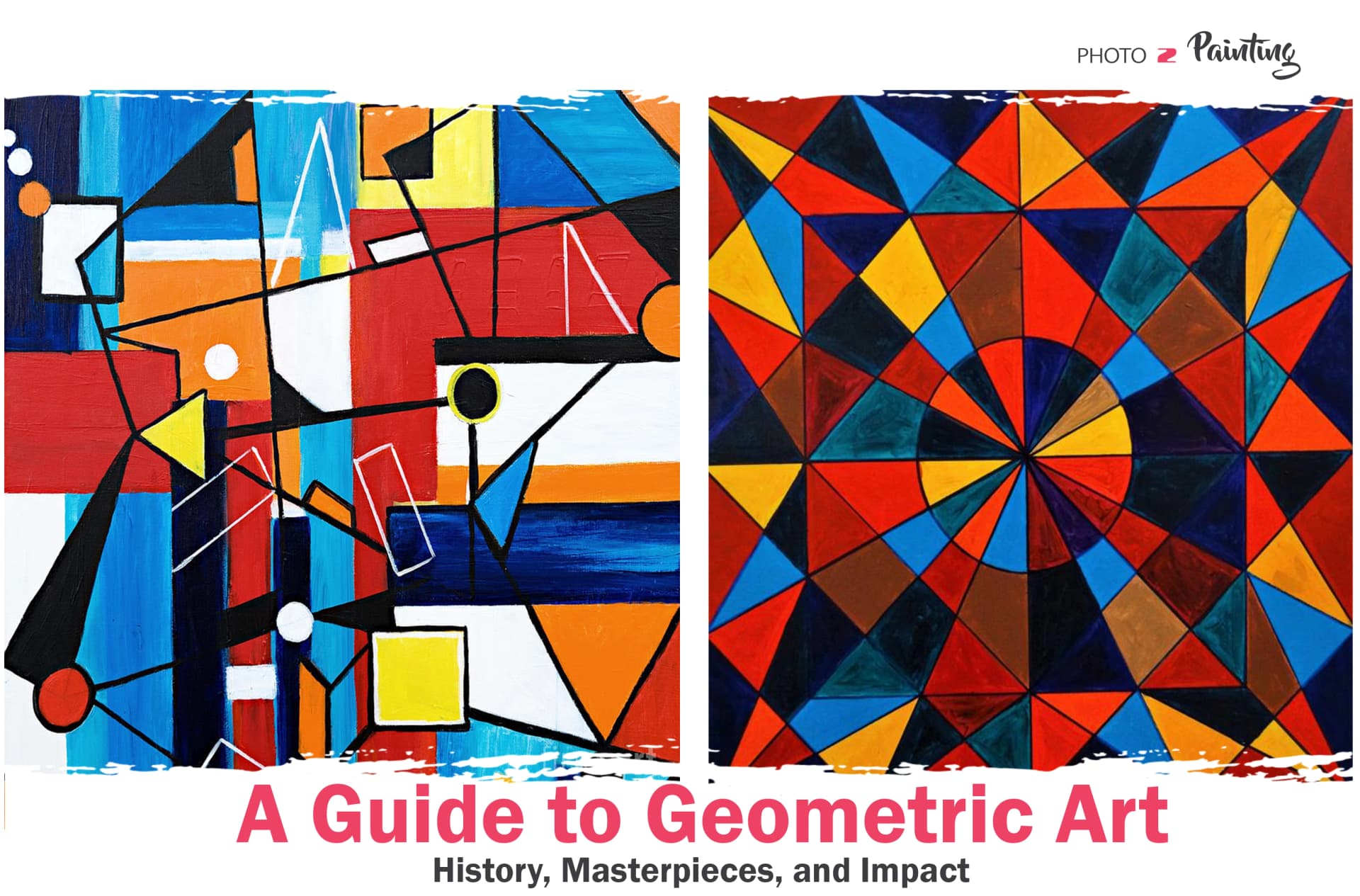

- Key Takeaways
- What is Geometric Art?
- The History of Geometric Art
- 1.Ancient Beginnings
- 2.Renaissance and Beyond
- 3.Modern and Contemporary Movements
- 1.
- Iconic Geometric Paintings
- 4.Composition VIII – Wassily Kandinsky
- 5.Victory Boogie Woogie – Piet Mondrian
- 6.Black Square – Kazimir Malevich
- 7.Movement in Squares – Bridget Riley
- 8.Rhombus 24 – Josef Albers
- 4.
- Popular Techniques in Geometric Art
- Popular Mediums in Geometric Art
- The Cultural and Philosophical Impact of Geometric Art
- 9.Geometric Art in Design, Architecture, and Fashion
- 10.Symmetry, Order, and Abstraction
- 11.A Universal Language
- 12.A Timeless Influence
- 9.
Geometric art can feel strange at first. We’re used to seeing paintings of landscapes, people, or animals—things that are alive and easy to connect with. But when a painting is made up of just shapes, like squares, circles, or triangles, it might seem unfamiliar. How can simple shapes express ideas or emotions?
As artist Sol LeWitt once said,
“The simplest shapes are the most profound.”
This unfamiliarity can make people feel disconnected from geometric art. Without familiar images like a tree or a face, it’s easy to assume the art is too abstract to understand or appreciate. Some might wonder if it has any meaning at all or if it’s just a collection of shapes put together at random. Yet this feeling of detachment is exactly what makes geometric art so fascinating—it challenges us to think differently and see beauty in simplicity.
Geometric art is more than just shapes. It’s a style that uses lines, patterns, and symmetry to create striking visuals. This approach has been a part of art across different times and cultures. From ancient Greek mosaics to Islamic patterns, and in modern movements like De Stijl, Cubism, and Op Art. Each use of geometry adds something unique, which makes it a universal language in art.
By learning about geometric art’s history, key works, and its influence on culture, you might start seeing not just the shapes, but a deeper meaning behind them. Geometric art, in general, might be seen in a whole new way.
Key Takeaways
Spiritual art isn’t just about how things look; it connects to emotions, ideas, and beliefs.
It can be tied to religion but doesn’t have to be. It’s about expressing the soul and inner thoughts.
Shapes, colors, and patterns are often used to show ideas like peace, energy, or transformation.
Spiritual art helps people reflect, find meaning, and connect to something bigger than themselves.
This type of art speaks where words can’t, inspiring feelings and deep reflection.
What is Geometric Art?
Geometric art is a style that uses shapes like squares, circles, triangles, and lines to create pictures or designs. Instead of showing things how they look in real life, like a tree or a person, it breaks everything down into simple forms. This makes it feel very different from traditional art, but it’s also what makes it so interesting.
One of the coolest things about geometric art is how precise it is. Artists carefully plan where every shape will go. They make sure everything fits together perfectly. Even though it’s about math and order, there’s still a lot of creativity. A single circle can mean different things depending on how it’s used—like unity, perfection, or even mystery.
Geometric art can also play tricks on your eyes. Some artists use patterns to create depth or movement. Others use illusions that make flat shapes look like they’re popping off the page. It’s art that’s not just pretty to look at—it makes you think.
The best part about geometric art is how it feels universal. No matter where you’re from or what language you speak, shapes like squares and circles are something everyone can understand. Instead of showing you something familiar, geometric art asks you to find your own meaning in the shapes.
Even though it’s simple, geometric art can be really powerful. A few lines or shapes can tell a story. make you feel something. It can also show you a whole new way to see the world. That’s what makes it so special.
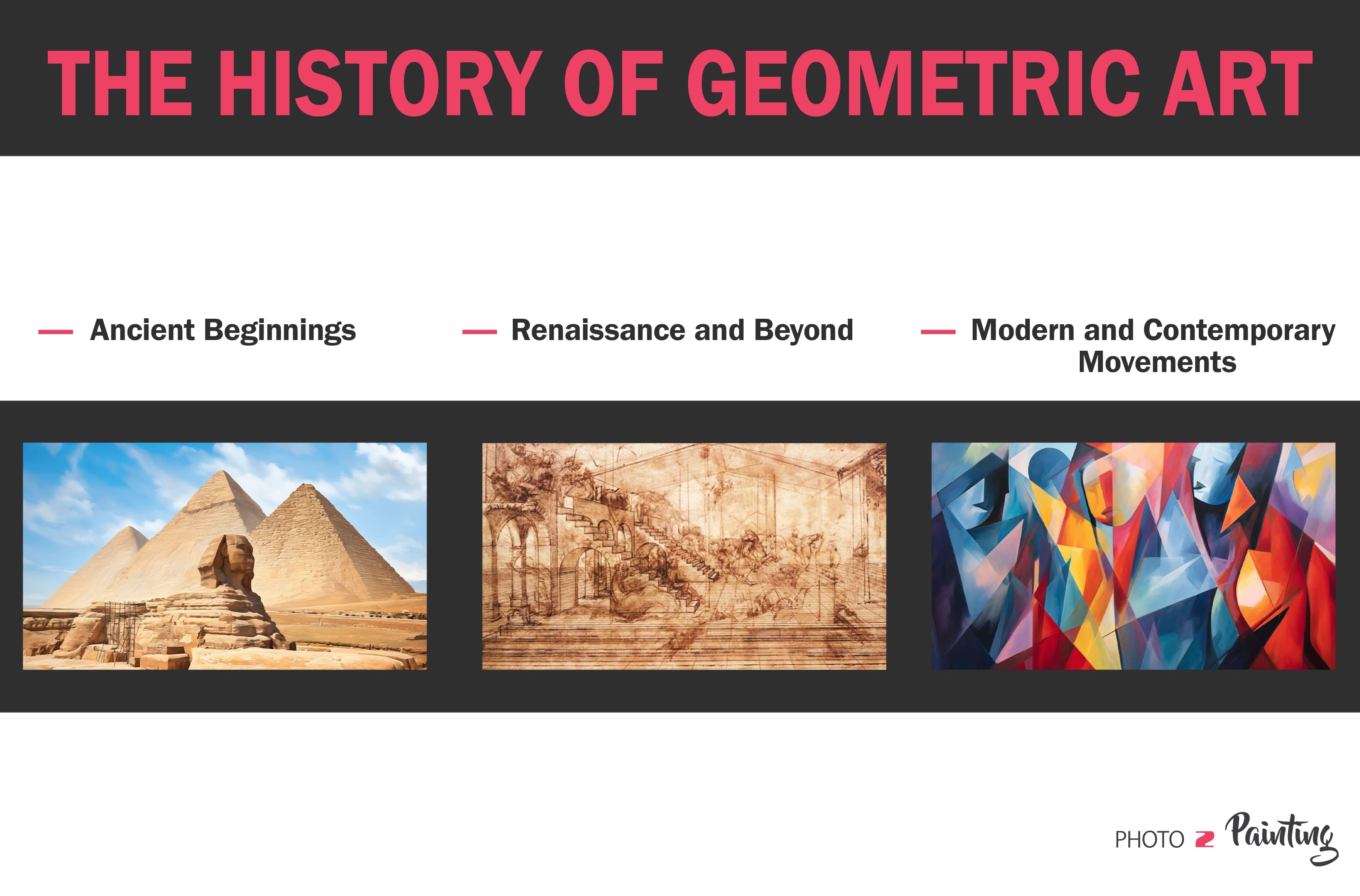
The History of Geometric Art
Geometric art has been a part of human creativity for thousands of years. While landscape painting traditionally focuses on natural scenery, geometric art offers a new way to interpret the environment through abstract forms and patterns. It’s amazing how shapes like circles, triangles, and lines have been used in so many different ways by cultures around the world. Whether it’s decorating pottery, designing buildings, or creating patterns in textiles, geometry has always played a big role in art.
What makes geometric art so timeless is its simplicity and versatility. Shapes are universal—they’re the same no matter where you are. However the way people use them changes depending on the time, place, and culture. This makes the history of geometric art incredibly rich and full of meaning.
Ancient Beginnings
Geometric art has been around for thousands of years, starting with some of the world’s oldest civilizations. In Egypt, geometry wasn’t just for math. It was used in the design of pyramids, temples, and decorations to represent harmony and balance. The perfect shapes of the pyramids weren’t just impressive—they symbolized order in the universe.
In Islamic art, geometry became a way to connect math and spirituality. Islamic artists created beautiful, intricate patterns in mosaics and textiles. They often used shapes like stars, hexagons, and circles to represent infinity and the divine. The Greeks also left their mark, especially with their pottery and architecture. Designs on Greek vases were full of repeating geometric patterns. Buildings like the Parthenon used symmetry and proportion to create a sense of perfection.
Renaissance and Beyond
Fast forward to the Renaissance, geometry took center stage in European art. Artists like Leonardo da Vinci and Filippo Brunelleschi used geometry to develop perspective. It is a way to make flat paintings look three-dimensional. Geometry turned into a tool for realism. It makes scenes in art feel as if you could step into them.
By the 19th century, though, artists were tired of copying reality. They started exploring new ways to express ideas. They focused less on what things looked like and more on the feelings or concepts behind them. This led to abstract art, where shapes and lines became tools for creativity instead of just decoration.
Modern and Contemporary Movements
The 20th century completely transformed geometric art. Artists like Pablo Picasso and Georges Braque started Cubism. They were breaking objects into geometric shapes like cubes, cones, and spheres. It was like seeing the world through a shattered mirror, where every angle and side appeared at once. Movements like Cubism and Suprematism often intersect with other styles, such as Surrealist paintings, to challenge traditional view of reality.
Meanwhile, the Bauhaus movement combined art, design, and geometry. It focuses on simple, functional shapes in everything from paintings to furniture and buildings. Later, Op Art emerged. It used precise patterns and shapes to trick the eye with optical illusions. You could stare at a piece and feel like it was moving! Minimalism also joined the party. It strips art down to its most basic forms—clean lines, simple shapes, and lots of empty space to make the viewer focus on the essentials.
Geometric art has come a long way, but it’s always been about more than just shapes. It’s a way to tell stories, express ideas, and create beauty through structure and balance. Today, it continues to inspire artists and designers to see the world in a whole new way.
Iconic Geometric Paintings
Geometric art is all about how artists use simple shapes to create something powerful. These shapes might look basic, but they carry big ideas. Some of the greatest artists in history have used geometric art to push boundaries and create paintings that still inspire us today. Let’s look at a few famous pieces and see how these artists turned simple shapes into masterpieces.
Composition VIII – Wassily Kandinsky
For Wassily Kandinsky, Composition VIII was more than just shapes on a canvas—it was a way to communicate feelings without words. He believed that every color and shape had a specific meaning. For example, Kandinsky thought circles represented harmony, while triangles felt sharp and dynamic.
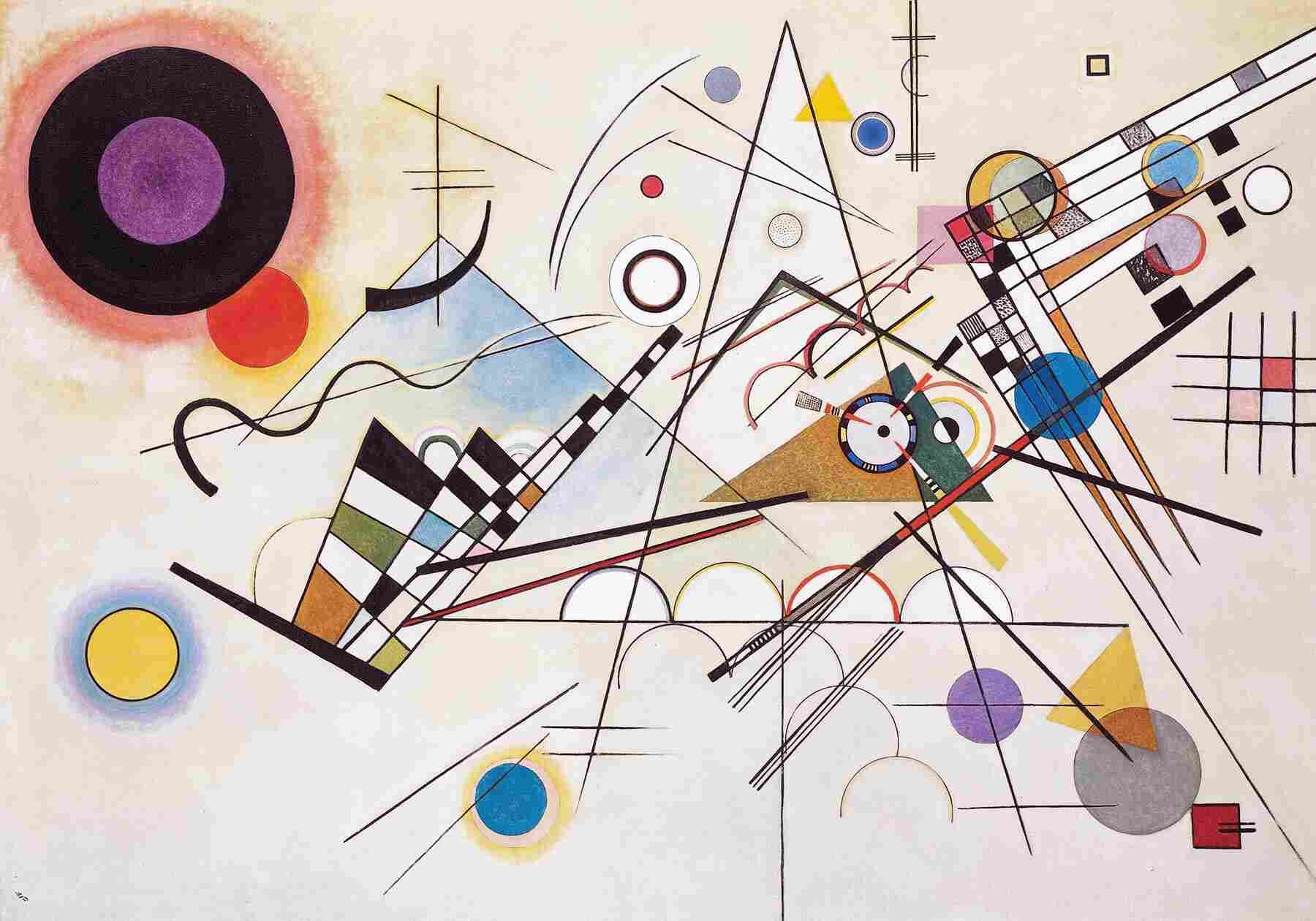
In Composition VIII, he combined bold colors with geometric forms to create a sense of movement and energy. It was almost like a chaotic but beautiful melody. This painting is one of his most important works because it shows how geometry and abstraction can express deep emotions. Kandinsky used art as a universal language that could connect with people’s hearts and minds.
Victory Boogie Woogie – Piet Mondrian
Piet Mondrian created Victory Boogie Woogie toward the end of his life, and it reflects the energy and excitement of New York City, where he was living at the time. The painting has no curves or natural forms; instead, it uses small squares and rectangles in primary colors—red, blue, yellow—along with black, white, and gray.
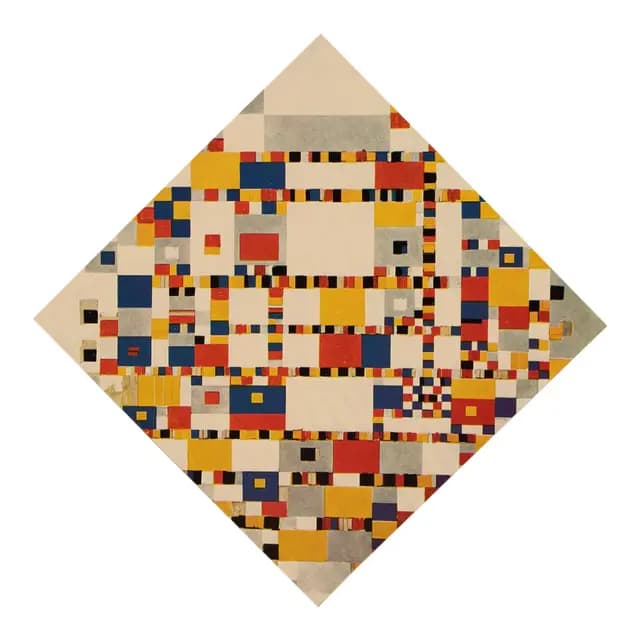
Mondrian arranged these shapes to create a rhythm that feels like jazz music, full of movement and improvisation. He wanted to show the balance and beauty of modern life, especially in a city as lively as New York. This piece also shows Mondrian’s love of simplicity, proving that even the most basic shapes can create something exciting and meaningful.
Black Square – Kazimir Malevich
When Kazimir Malevich painted Black Square, he wasn’t just making a simple artwork—he was starting a revolution in art. Malevich called this style Suprematism, which focused on pure forms and colors rather than realistic images. Black Square was meant to represent a "zero point," where art could move away from storytelling and focus on raw emotion and thought.
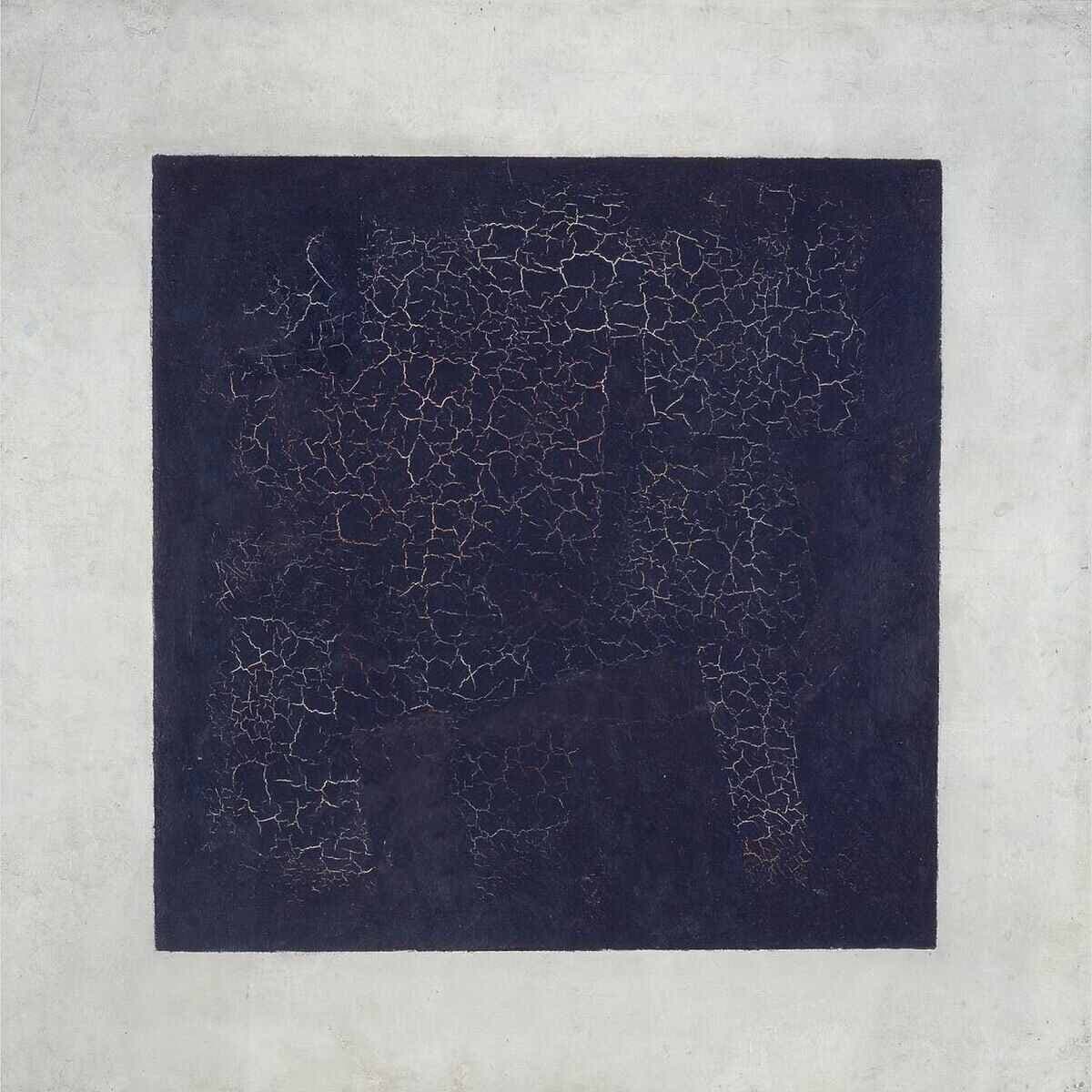
Malevich displayed the painting like a religious icon, placing it in the top corner of a room where you’d usually find sacred art. He believed this style of painting showed freedom—freedom from traditional rules of art and from the need to represent the real world. Even today, Black Square is considered one of the most daring and influential works in modern art history.
Movement in Squares – Bridget Riley
Bridget Riley’s Movement in Squares is a masterpiece of Op Art, an art style that uses patterns to create optical illusions. At first glance, this painting looks simple—just a series of black and white squares. But as you look closer, the squares seem to bend and move, creating a rippling effect.
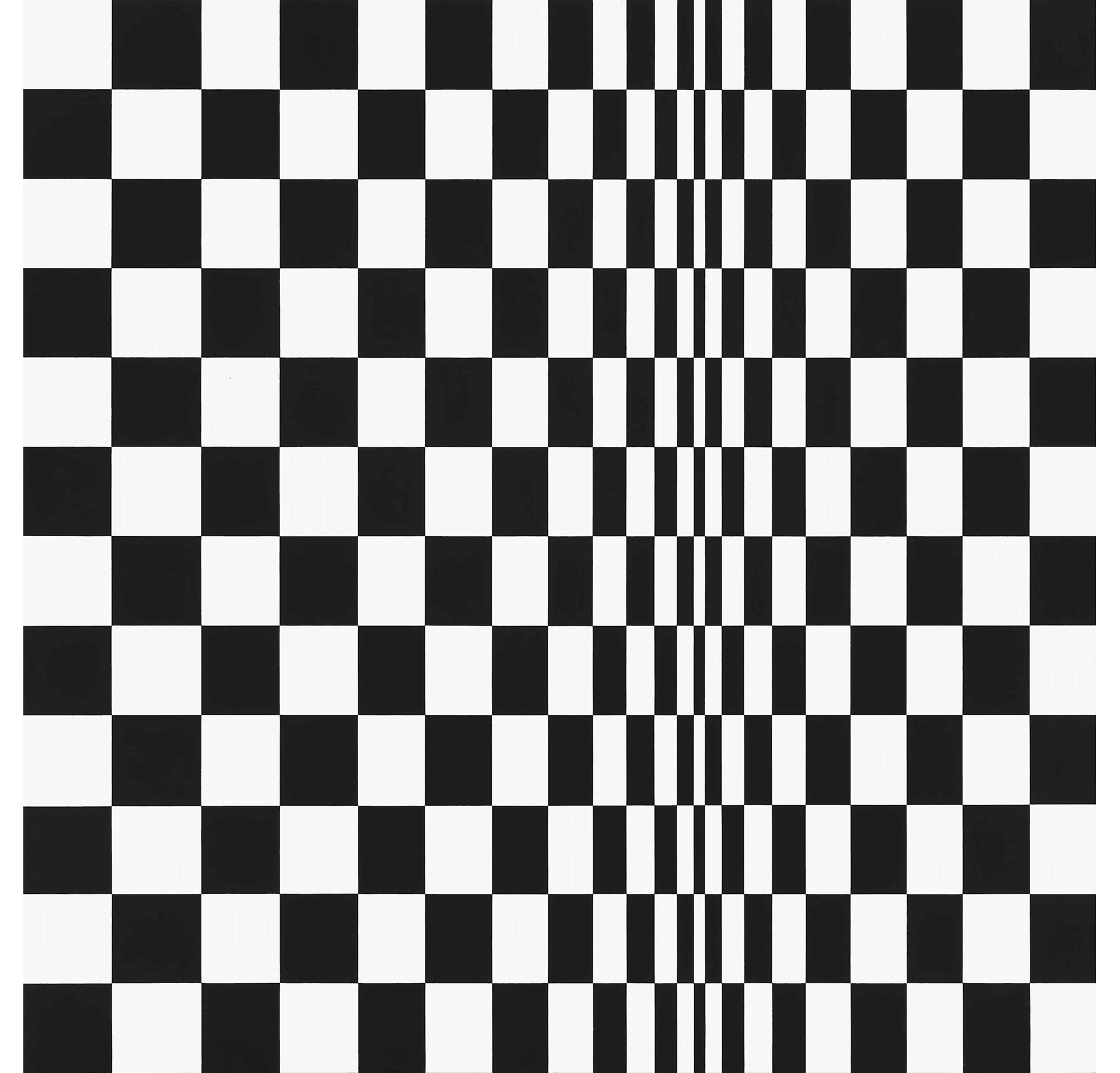
Riley was fascinated by how our eyes and brains react to shapes, and she used geometry to explore this idea. She wanted viewers to feel like the painting was alive, shifting and changing as they looked at it. Her work is a perfect example of how geometry can go beyond just being static shapes and create a sense of motion and interaction.
Rhombus 24 – Josef Albers
Josef Albers was a master of using geometry and color in creative ways, and Rhombus 24 is a great example of his genius. In this painting, Albers used overlapping rhombus shapes to create depth and illusion. The colors in each rhombus seem to shift and interact with one another. It made the painting feel alive.
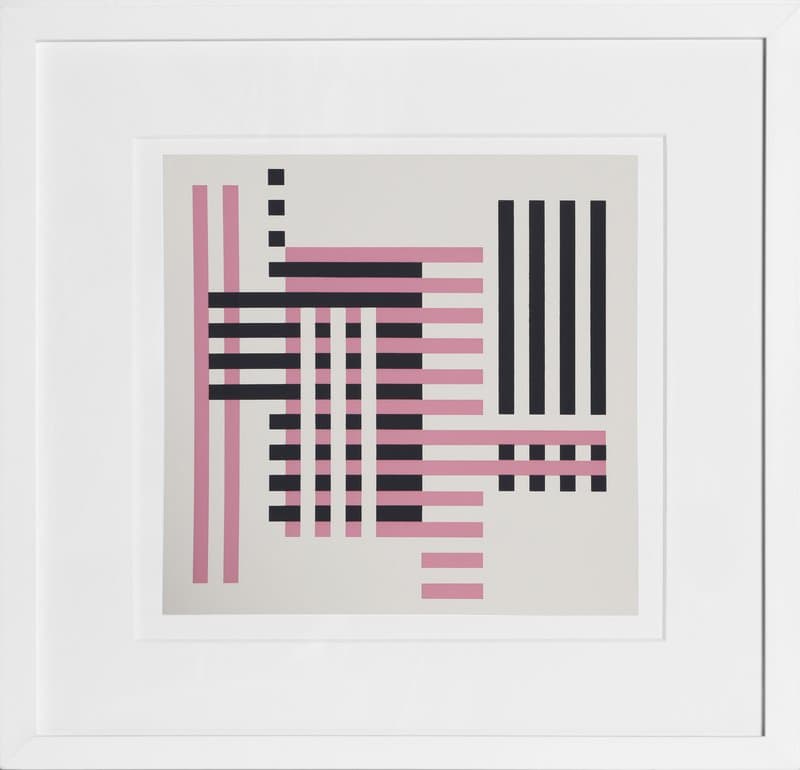
Albers was fascinated by how colors could change depending on what was around them, and he used simple shapes to explore this idea. Rhombus 24 shows that even the most basic forms can feel complex and dynamic when combined in the right way. Albers wanted his viewers to think about how they see and experience color and space, making his work both simple and thought-provoking.
Popular Techniques in Geometric Art
Artists use many different techniques to make geometric art, combining creativity with careful planning. Traditional tools like rulers, compasses, and protractors help them draw straight lines, perfect circles, and precise angles. Stencils and templates are useful for creating patterns that repeat or for drawing shapes exactly the same each time. For big projects, like murals on walls, some artists use projectors to make their designs larger while keeping everything in proportion. Painters also use masking tape to make sure their lines stay sharp and clean.
Some artists enjoy drawing freehand, where they rely on their own skills instead of tools. This adds a more personal and natural touch to their work. Other artists use math to guide their designs, carefully calculating how shapes and lines fit together. Today, many artists also use digital tools, like apps and computer programs, to create perfect geometric designs. These tools make it easy to experiment with patterns, colors, and effects that might be hard to do by hand.
Artists today can use tools that turn a photo into a sketch to start their geometric compositions, blending traditional methods with innovative technology.
Popular Mediums in Geometric Art
Geometric art can be made using lots of different materials, and each one gives the art a unique look and feel. Artists choose their medium depending on the style and message they want to create. Considering painting sizes is crucial for geometric art, as larger canvases allow for more intricate patterns, while smaller pieces highlight simplicity and precision.
Acrylic Paint
Acrylic paint is one of the most popular choices for geometric art because it dries fast and gives a smooth, flat finish. This makes it great for sharp lines and bold colors, which are common in geometric designs. Acrylic is also very flexible—it can be used on canvas, paper, walls, or even wood. Since it dries quickly, it’s not the best for blending colors. However that’s usually not a problem for geometric art, where clean edges are more important than soft transitions. For anyone exploring geometric designs, acrylic painting offers an ideal medium for precision and vibrancy.
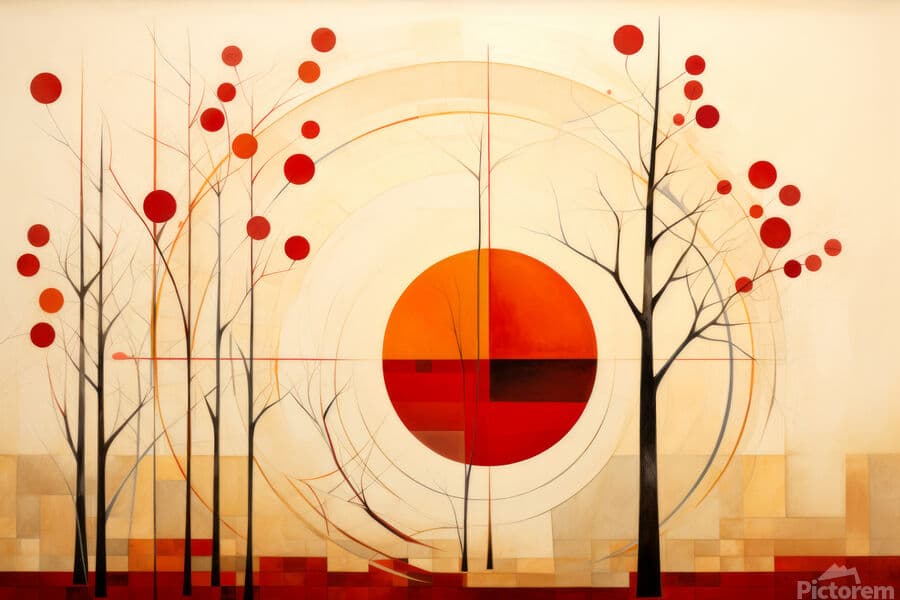
Oil Paint
Oil paint is another medium that many geometric artists use. It dries much more slowly than acrylic, which gives the artist more time to mix and blend colors. This is helpful for creating gradients or shading that adds depth to the shapes. However, oil paint can be harder to work with if you want very crisp edges because the paint stays wet longer and can smudge. Despite this, geometric oil paintings bring a richness and depth that makes the shapes feel more dynamic and vibrant.
Digital Tool
Digital tools are becoming more and more popular for creating geometric art. Apps like Procreate or programs like Adobe Illustrator let artists make perfect shapes, experiment with colors, and create super-detailed designs. Digital tools are especially good for styles like Op Art, where patterns need to be very precise to create optical illusions. One big advantage of digital art is that it’s easy to fix mistakes or try new ideas without starting over. Some artists prefer traditional methods, but digital tools make it possible to try things that would be almost impossible with paint or paper.
Mixed Media
Mixed media is another exciting option for geometric artists. This is when artists use more than one material in the same artwork. For example, they might paint geometric shapes over a photograph, use cut pieces of colored paper to create designs, or add 3D elements like wood or metal. Mixed media adds texture and depth, making the art more interesting to look at. It can take more time to plan, but the results are often unique and eye-catching.
Every medium has its own strengths, and artists can pick the one that best fits their vision. Whether it’s with paint, computers, or mixed materials, geometric art always finds new and exciting ways to come to life.
The Cultural and Philosophical Impact of Geometric Art
From ancient mosaics to modern skyscrapers, geometric art has shaped the way we see and create beauty in the world around us. With its clean lines, bold patterns, and universal appeal, it inspires everything from buildings and clothes to the way we think about balance and order in life.
Geometric Art in Design, Architecture, and Fashion
Geometric art in architecture has had a big influence on how buildings are designed. Architects use shapes like triangles, hexagons, and circles to make structures that are both beautiful and strong. Frank Lloyd Wright, a famous architect, used geometric patterns in his buildings to combine modern ideas with natural forms. It helps create designs that feel timeless.
In fashion, bold geometric patterns grab attention and make powerful statements. Designers like Yves Saint Laurent and Issey Miyake used these shapes in their clothing lines to create fresh, modern looks. Geometric shapes are also common in furniture and interior design, where clean lines and symmetrical arrangements make spaces feel neat, stylish, and balanced.
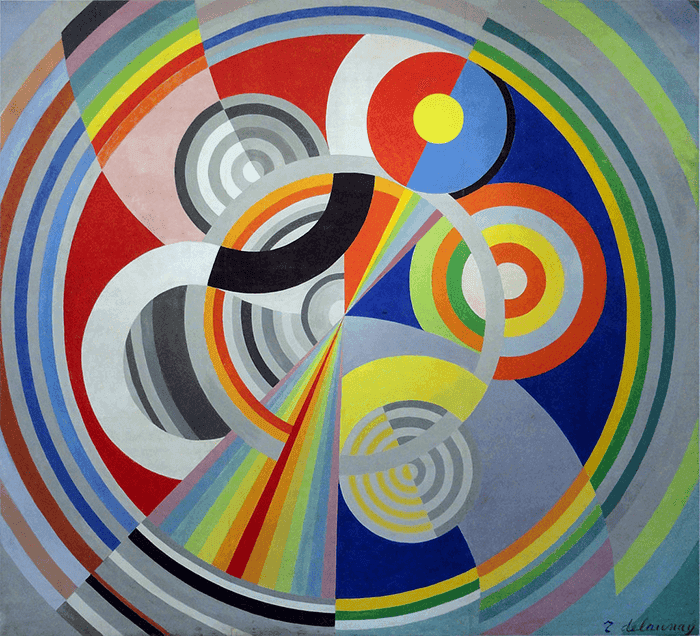
Symmetry, Order, and Abstraction
Geometric art history isn’t just about practical uses—it also explores deeper ideas like balance and simplicity. People are naturally drawn to symmetry because it feels calming and organized. Artists use symmetry to make their work feel balanced, creating a sense of harmony in their designs.
At the same time, geometric art is deeply connected to abstraction. Instead of showing real things like people or landscapes, it focuses on simple shapes and forms. This lets viewers interpret the art in their own way, finding personal meaning in the lines, circles, and patterns.
A Universal Language
These ideas of balance and order are seen in geometric art across cultures. For example, Islamic art is known for its intricate geometric patterns, often used in mosques and tiles to symbolize infinity and spirituality. The Alhambra, a famous palace in Spain, is one of the best examples of this tradition, covered in stunning, detailed designs.
In Africa, tribal art often features geometric patterns in beadwork, carvings, and textiles. These designs aren’t just decorative—they also tell stories about nature, life, and community traditions. In Japan, origami uses geometry to fold paper into amazing shapes, showing how math and art work together. South American textiles also include bold geometric designs that represent a connection to nature and cultural identity. Across the world, geometric art history proves that shapes and patterns are a universal language that can express beauty and meaning in unique ways.
A Timeless Influence
Geometric art is more than just shapes. It blends design, deep ideas, and cultural traditions into something timeless. By focusing on simple forms, it helps us notice structure, balance, and harmony in the world around us.
Its influence can be seen everywhere—from modern architecture and public art to everyday objects like smartphones. Artists today are also using new technologies like digital tools and 3D printing to explore geometric patterns in exciting ways, proving that this art form continues to evolve.
Geometric art reminds us that even the simplest shapes can inspire creativity. How might the influence of geometric patterns shape the future of art and design?
Conclusion
Geometric art has a timeless appeal that continues to inspire and captivate people across cultures and generations. Its simplicity, precision, and versatility make it a unique form of artistic expression. Whether in ancient mosaics, modern skyscrapers, or abstract paintings, geometric art shows us how shapes and patterns can create beauty, tell stories, and convey powerful emotions.
In today’s art world, geometric art is as relevant as ever. It influences architecture, design, and fashion, blending seamlessly into both traditional and digital mediums. Artists continue to experiment with geometric forms, finding new ways to express ideas and push the boundaries of creativity. Its universal language of shapes allows it to remain meaningful and accessible to people from all walks of life.
As artist Carl Andre once said,
“I think art is expressive but it is expressive of that which can be expressed in no other way.”
Geometric art perfectly reflects this idea. It takes simple shapes—things that seem ordinary—and uses them to express concepts and emotions that can’t be captured in words or images alone.
Above all, geometric art reveals the boundless potential of human creativity. It invites us to see the world differently and reminds us that even the most basic forms hold endless possibilities.
Geometric art’s simplicity and versatility make it a popular choice for those looking to commission a painting that blends personal taste with timeless design.
Frequently Asked Questions
What art shows geometric shapes?
Art that shows geometric shapes is known as geometric art. It features clear, defined shapes like circles, squares, triangles, and rectangles. This type of art has been around for centuries and can be found in both ancient and modern works. The movements like Cubism, De Stijl, and Op Art focus on using shapes and lines to create unique and eye-catching works. Artists such as Piet Mondrian, Wassily Kandinsky, and Kazimir Malevich are well-known for their use of geometric shapes in their paintings.
What is considered a geometric design?
A geometric design is a pattern or image created with simple shapes like lines, circles, triangles, and squares. These designs are usually balanced, symmetrical, or repeated to create an orderly look. You can find geometric designs in many places, such as art, fashion, and architecture. For example, tiled floors often have repeating geometric patterns, and some abstract paintings use only shapes to create beautiful, bold designs. Geometric designs are all about structure and precision, but they can also be creative and artistic.
What is the geometric painting style called?
The geometric painting style is called geometric abstraction. In this style, artists focus on shapes, lines, and colors rather than trying to represent real objects or people. It’s about creating interesting designs and exploring how basic forms interact. Geometric abstraction became popular in the early 20th century, with movements like De Stijl and Suprematism.
Who is the father of geometric art?
Piet Mondrian is often called the "father of geometric art" because his style of painting made geometric abstraction very popular. He created iconic works with straight black lines forming grids filled with primary colors like red, blue, and yellow. His art was simple but powerful, inspiring modern art, design, and architecture. However, the use of geometric shapes in art goes back much further. Ancient Greek artists used geometric patterns in pottery and architecture, and Islamic artists developed complex geometric designs in their mosaics and buildings. While Mondrian wasn’t the first to use geometry in art, he is one of the most famous figures in the modern era.
What is Piet Mondrian’s most famous painting called?
Piet Mondrian’s most famous painting is "Composition with Red, Blue, and Yellow." This painting features a grid made of black lines with blocks of red, blue, yellow, and white. It’s a perfect example of the De Stijl movement, which focused on using simple shapes and primary colors to create balanced and harmonious designs. This artwork became a symbol of modern art and has influenced graphic design, fashion, and architecture.
Is mandala a geometric art?
Yes, a mandala is a form of geometric art. Mandalas are circular designs made up of repeating patterns and shapes, often arranged in a balanced and symmetrical way. They have been used in Hinduism and Buddhism for centuries as a spiritual tool for meditation and representing the universe. Mandalas are very detailed and often look like wheels or flowers, with each part of the design having its own meaning. While they are deeply symbolic, mandalas are also beautiful examples of how geometry can create complex and meaningful art.
Is abstract art always geometric?
No, abstract art is not always geometric. Abstract art is any art that doesn’t try to look like real objects or people. It can be very different depending on the artist’s style. Geometric abstraction is one type of abstract art, and it focuses on using clear shapes like squares and circles. However, there is also abstract art that uses flowing, organic forms inspired by nature, or expressive, messy lines and colors to show emotions. Geometric abstraction is just one way to create abstract art, but not all abstract art is geometric.
George, CEO of Photo2painting, is a passionate art lover and entrepreneur. He founded Photo2painting.com from scratch, inspired by his artist friends. As the company's CMO, he manages content and marketing.
Excellent Customer Reviews















































































































































